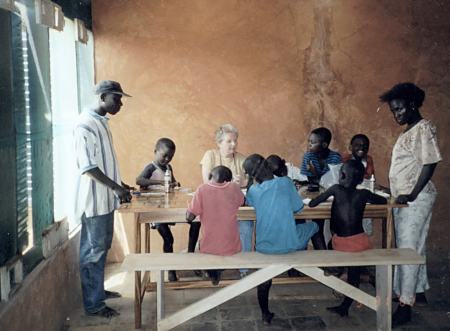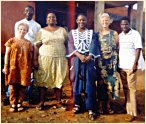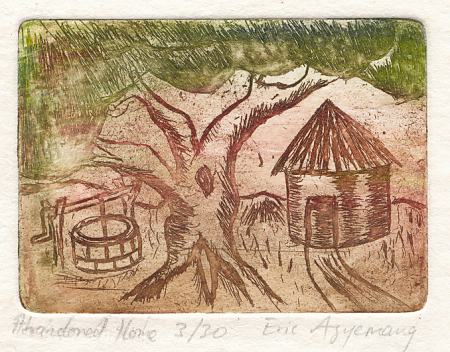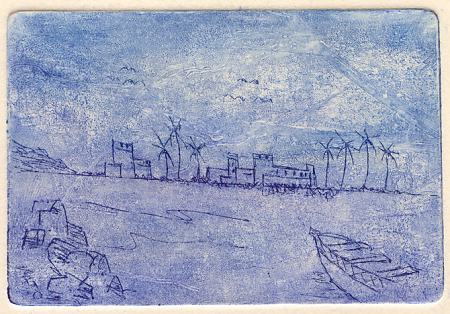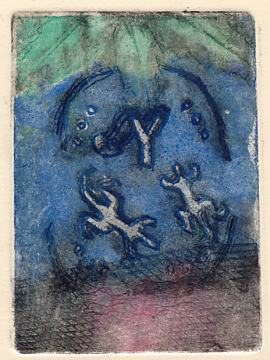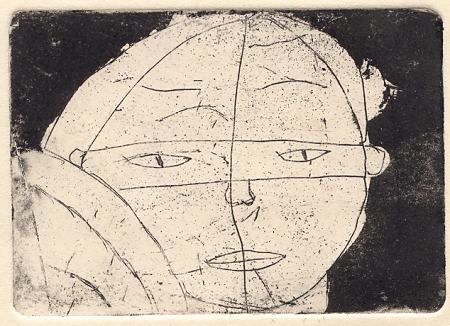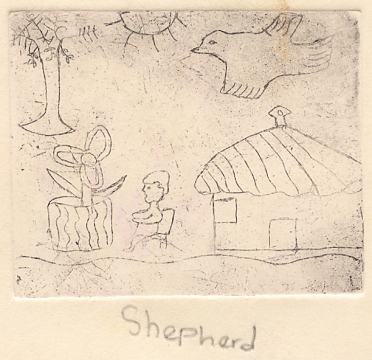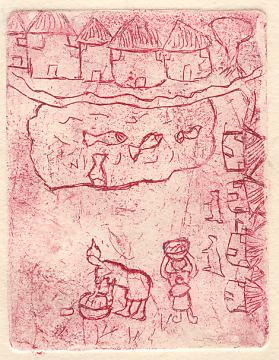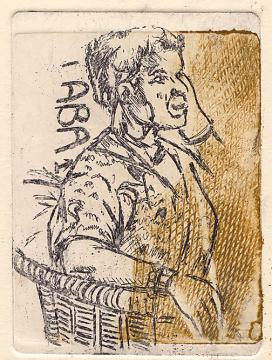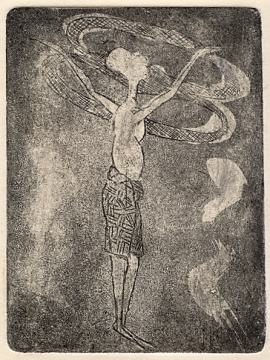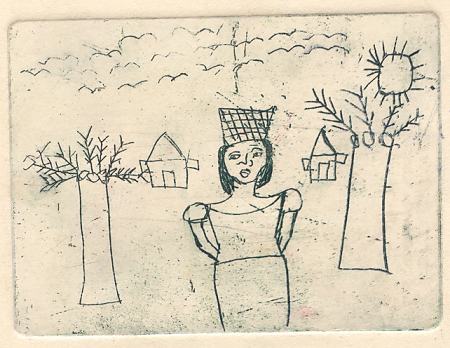ETCHING WORKSHOPS, March 8 - April 17, 2002
Bethia Brehmer, a Wellfleet, MA printmaker, conducted adult, children and teacher workshops in a media new to most of the participants.
Beth introduced a new printing process to the workshop participants. Because etching requires supplies like copper plates that aren't readily available in Ghana, most people in the workshops had not experienced this technique before.
The results were impressive. We felt that the technique might be too difficult for the children, but even they produced some nice results. The adults were able to master the more intricate steps and a jeweler who attended was able to use the etching technique to create some silver earrings.
My only regret from the workshop is that the attendees will probably not be able to continue using their etching skills ...at least not until CCC, Inc. or perhaps one of the Universities sets up an etching studio.
Beth would like to return to Ghana and we are trying to figure out what technique she will teach next.
We had originally intended to teach etching, bookbinding and short story writing, but it soon became apparent that time would not allow for all three, so I let Beth use most of the time to teach etching and I did a short workshop with the children on bookbinding and a one day workshop with teachers on handbinding techniques.
The teachers were disappointed that we only had one day to work, so when my schedule allows, I will go back and continue.
And the story writing will happen in August 2003. James Culver, Jr., a published author who concentrates on cultural diversity, will work with me at CCC, Inc. for a month to teach and record memory stories which will then be published in book form.
Bethia Brehmer's report
I spent six weeks, March 8-April 17, 2002 in Ghana, West Africa teaching three etching workshops. The setting was Aba’s – AKA Ellie Schimelman’s – Cross Cultural Collaborative on the ocean in the capitol, Accra. I have traveled a lot, but this was one of the most interesting adventures of my life.
Ellie has been studying and spending time in Ghana for decades. Several years ago she bought ocean view land in Accra. She has been leading cultural tours to Ghana to finance the building of a center where outsiders could learn Ghanaian arts and crafts and vice versa. Ellie’s house is amazing. It is built of traditional, indigenous materials. It has a thatched roof, no glass, only closing shutters and screens, adobe walls inside and out, and unglazed tile floors. It feels like living in a pottery jar. The exterior walls are to be painted with traditional Mali decorations.
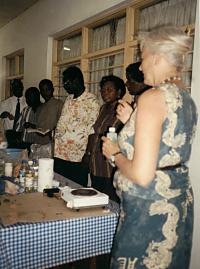 Her first project, summer 2001, was a mosaic wall with a California artist and neighborhood children.
They created a mosaic depicting the history of the area on a couple of huge sections of the wall surrounding the property. I was there to see the beautiful results. I know the kids adored it because
they all stopped me on the street to ask if I knew Laurel and when she was coming back. No, I don’t know Laurel; I live on the other coast, and yes, she’s coming back to continue the mosaic on the arched entrance.
Her first project, summer 2001, was a mosaic wall with a California artist and neighborhood children.
They created a mosaic depicting the history of the area on a couple of huge sections of the wall surrounding the property. I was there to see the beautiful results. I know the kids adored it because
they all stopped me on the street to ask if I knew Laurel and when she was coming back. No, I don’t know Laurel; I live on the other coast, and yes, she’s coming back to continue the mosaic on the arched entrance.
With the idea of putting a professional spin on my wanderlust, Ellie and I began to talk about my teaching etching in Ghana. We talked and talked and talked. I work in a number of media, oil painting, watercolor, copper fountains, and most recently, shadow boxes, but etching is what I’ve done the longest and know best. We started talking in November and December 2001.
My biggest concern was importing an entire etching studio to a country where essential supplies were unavailable. Because of the poverty in Ghana, shipped packages are often stolen. I made a list and checked it twenty times. Ellie consulted with her Ghanaian friends about availability of chemical and solvents. I also talked extensively to Susan Clark at Graphic Chemical and Ink Co. She was very informative about toxicity and legality of flying with chemicals. She also donated $300 worth of supplies to the project. I packed a less toxic stop out varnish and ferric chloride crystals knowing I could get – but didn’t want to use - nitric acid in Ghana. I documented everything assuming the airline would find my luggage, if examined, bizarre if not alarming. The supplies survived the journey, including my tiny, demo size Dick Blick press, which fit neatly into a huge rolling suitcase. I have never traveled so heavy! One bag was nearly the 70 pound limit with blotters, paper, inks, precut copper plates, etc, etc, etc.
With her extensive network of contacts in Ghana, Ellie set up three workshops, the first and second through MMFORA, a nonprofit dedicated to the education of children. A week after I arrived we did a three day workshop with art professionals from publishing houses and universities, including the chairman of the art department at the University of Science and Technology at Kumasi. To say that I was nervous is an understatement. I felt unsure that the set up would work. Would you believe that we melted the hard and soft grounds and the aquatint rosin over a wood fire in the yard? The great Atlantic Ocean in the background somewhat mitigated the circumstances.
You may imagine the challenges. Ellie had just had the electricity hooked up. But that didn’t mean that it worked. I would say, on average, it was out every few days for at least a few hours. Same with the water. Thank heavens for water storage tanks and cisterns. And the phone? Ellie’s never worked reliably, and neither did many others. And it was hot! 33 C. and more (x 1.8 + 30 = 91 F). and humid. The nights were an ideal temperature, but the days were unbearable, and of course I was teaching during the day.
 There were 25 children in the second class. The minimum age was supposed to be ten.
Well, apparently that didn’t apply to siblings. The youngest were maybe 5 or 6. When I twice gave directions to a particularly young girl, she looked up at me with beautiful, uncomprehending eyes and replied,
each time, “Yes, thank you.” In retrospect, it’s funny. Everyone loved to print. They raced through the process of grounding, designing and etchings, lining up at the press to run lots and lots of prints.
After class, while waiting for the bus, the students formed a circle and played singing and clapping games. We all participated. I was enchanted.
There were 25 children in the second class. The minimum age was supposed to be ten.
Well, apparently that didn’t apply to siblings. The youngest were maybe 5 or 6. When I twice gave directions to a particularly young girl, she looked up at me with beautiful, uncomprehending eyes and replied,
each time, “Yes, thank you.” In retrospect, it’s funny. Everyone loved to print. They raced through the process of grounding, designing and etchings, lining up at the press to run lots and lots of prints.
After class, while waiting for the bus, the students formed a circle and played singing and clapping games. We all participated. I was enchanted.
The third and last class was sponsored by the Ministry of Education and included high school art teachers. By now I’m on a roll and having fun. I began to enjoy teaching and continued asking what etching supplies might be locally available. It appears, from talking to both adult classes that there are no etching studios or classes in Ghana. People knew about etching but they’d never done it before. Ben Adipah, the curriculum director, took my little press to a shop to see about having a press machined in Ghana, certainly a lot less expensive than buying or commissioning one here.
Ghanaian people were very friendly and funny. As a former British colony, everyone spoke English. Our accents were a source of confusion to most everyone. I often needed a translator because I talk funny. But I had a great time. Many beautiful etchings were created, even by the children. Ellie wished to include depictions of village life, so many etchings are evocative of the culture and country. The enthusiasm of the students was wonderful.
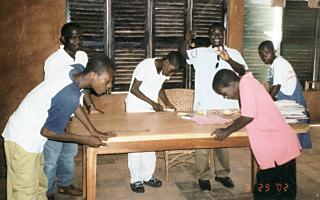 Teaching gave my African trip meaning, focus, and involvement. To share ideas with another culture was creative in many ways. A Ghanaian carpenter made fifteen mahogany shadow boxes for me, eight of
which I used in a mixed media show two weeks after my return. I watched the foremost kente cloth weaver, saw recycled glass beads formed and fired, visiting Cape Coast slave castles (heart wrenching),
walked the canopy walk (scary) in Kamkun National Park, and, after a beautiful canoe ride through dense greenery, was enchanted by Nzulezo, a village on stilts in a pristine lake.
Teaching gave my African trip meaning, focus, and involvement. To share ideas with another culture was creative in many ways. A Ghanaian carpenter made fifteen mahogany shadow boxes for me, eight of
which I used in a mixed media show two weeks after my return. I watched the foremost kente cloth weaver, saw recycled glass beads formed and fired, visiting Cape Coast slave castles (heart wrenching),
walked the canopy walk (scary) in Kamkun National Park, and, after a beautiful canoe ride through dense greenery, was enchanted by Nzulezo, a village on stilts in a pristine lake.
Ellie was in Ghana again July and August. We met days after her return to Brookline (MA) when she was still jet lagged, and waking at 3 AM. There were projects on top of projects. They built the mosaic entrance archway, taught children painting and drawing, held classes with traditional and contemporary potters, and designed pottery furniture. We started talking about applying for grants, and my going back to teach printmaking in February. We looked at photos and talked and talked and talked. I guess I gotta go to Ghana.
-- Bethia Brehmer
Participants
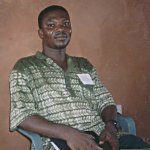
college teacher
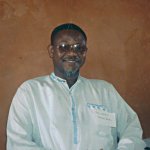
Chair Art Dept. KUST

Ghana University Press
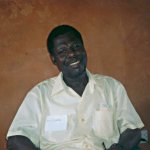
secondary school teacher

jeweler

college student
![]()

Aba, Fred Odamtey, Esi Sutherland-Addy, Dr. Pelagah, Behtia Brehmer, Mr. Sowah

Bethia, Aba and the kids
